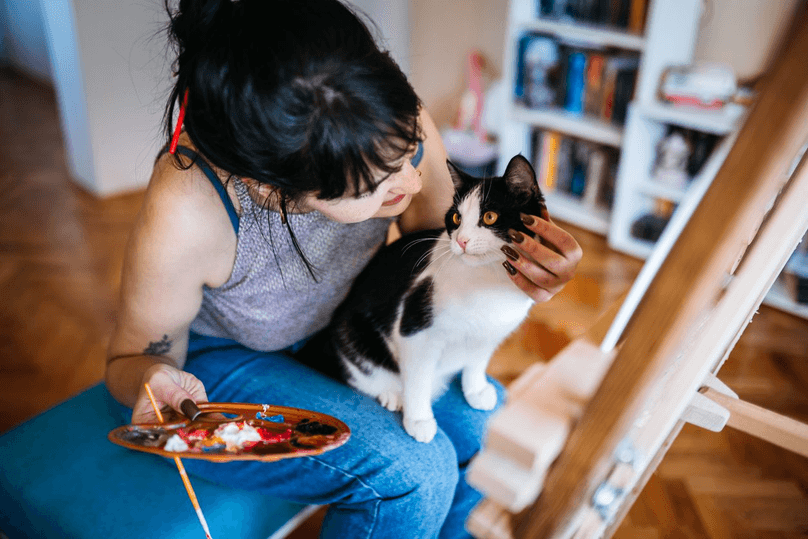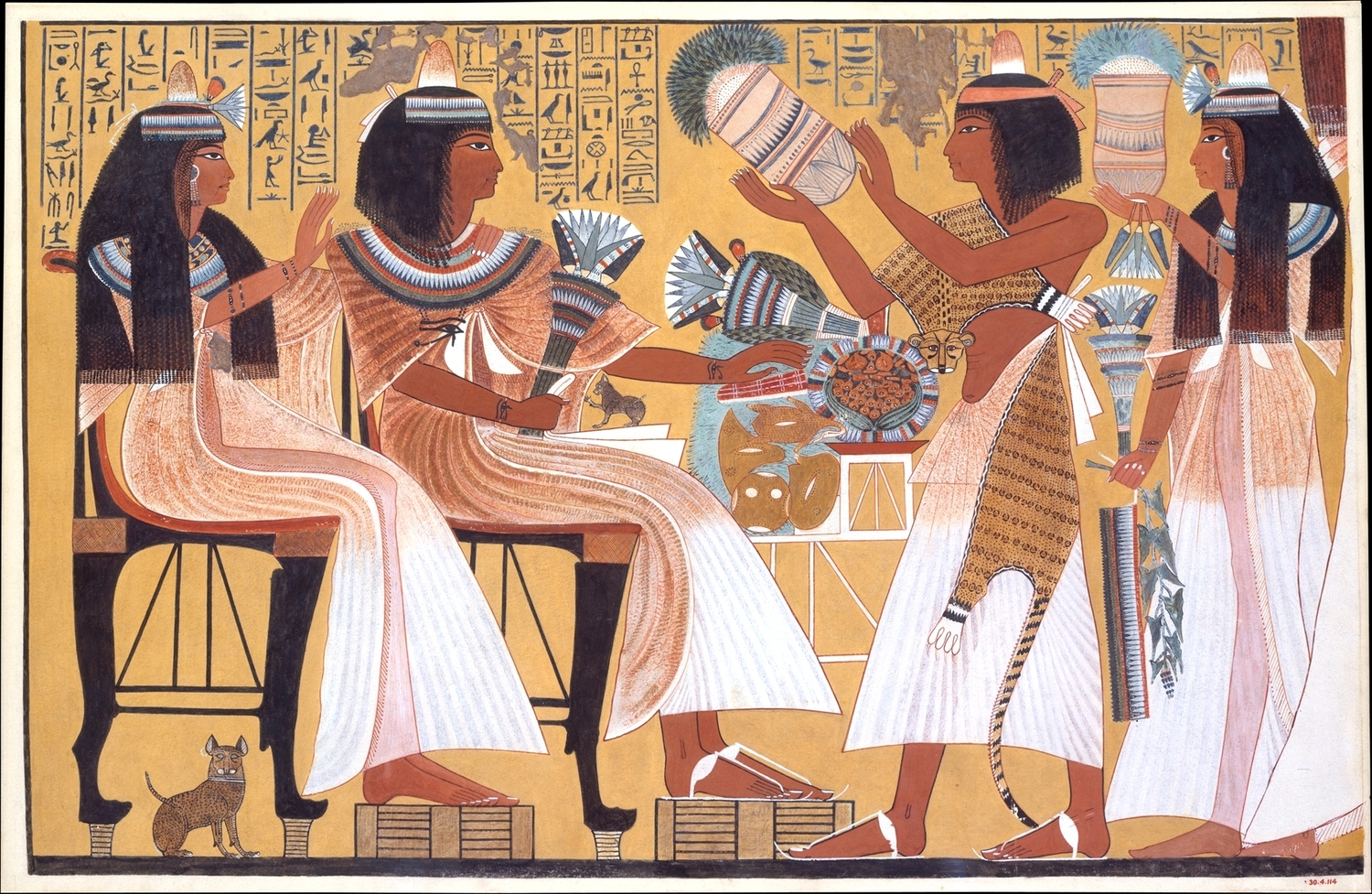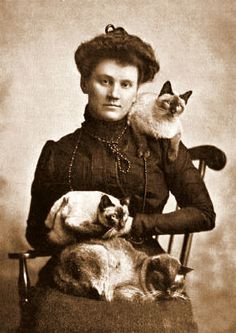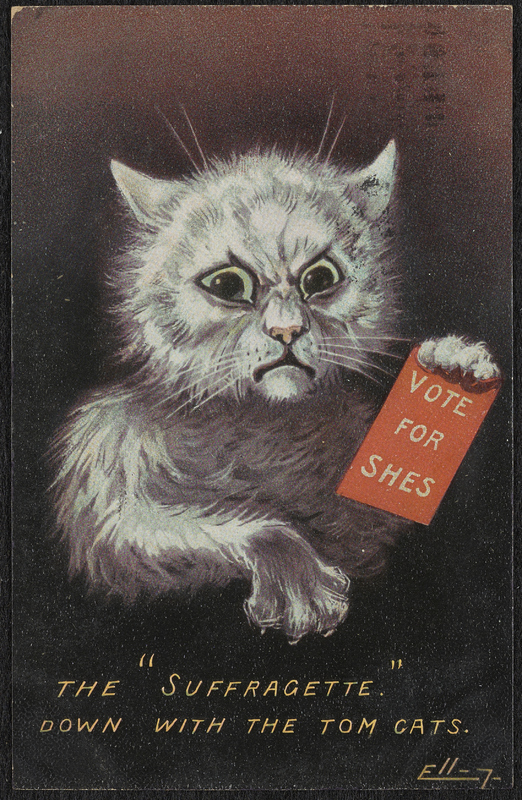
In the collective imagination, few characters are as vividly sketched and widely recognized as the “cat lady.”—a woman defined by her surplus of cats and lack of human companionship. Far from being a modern invention, this archetype has roots that stretch back through history, evolving alongside shifts in society’s understanding of gender, attitudes towards animal care, and the stigmatization of solitude.
In celebration of National Cat Lady Day, let’s dive into the intriguing evolution of the cat lady stereotype, exploring its origins, media portrayals, and the real-life impact on women and their whiskered sidekicks.
Goddess Status
Diving way back into history, ancient Egypt holds some of the earliest and most fascinating chapters of the cat-human saga. Here, cats weren’t just pets; they were revered, and woven into the fabric of daily life and spirituality.
Ancient Egyptian women, in particular, shared a special connection with these revered creatures. Cats were seen as protectors, not just of the home from pests but also guarding against evil spirits. They were closely linked to the Egyptian goddess Bastet, who represented home, femininity, and childbirth.
The bond between women and felines was a relationship rooted in mutual respect and adoration, with cats often depicted alongside their female companions in art and hieroglyphs, showcasing their esteemed status in society.
Madness in the Middle Ages
Unfortunately, the Middle Ages weren’t as welcoming to our feline friends. The combo of women cozying up with a casa full of cats was a red flag for their communities in medieval Europe. Why? The cute, cuddly cat wasn’t considered a loyal companion like they are today; they were often seen as a direct line to the underworld.
Picture this: It’s the 15th century, and cats have the unfortunate reputation of being essential tools for the dark arts. Black cats, with their mysterious aura, got the worst rap, often accused of being undercover agents for the devil.
If you were a woman, especially one enjoying her own company a bit too much or, heaven forbid, living solo, you might as well have had “I’m up to no good” tattooed on your forehead. Having a cat? That was the cherry on the suspicion sundae.
This association threw shade on the cats and their human companions, marking them as outsiders and stirring up all sorts of trouble.
The Bubonic Plague Myth
During this era, cats were tragically misjudged as carriers of the bubonic plague. This devastating disease swept through Europe, causing widespread panic, and the population was hungry for a scapegoat.
While cats weren’t executed en masse during the plague (rumors of mass exterminations during the Middle Ages are thankfully a myth) they were still wrongfully blamed for spreading disease. Ultimately, this lead to the stigmatization of the so-called “crazy cat lady,” intertwining a health crisis with deep-seated suspicions of women’s relationships with cats.
The Victorian Spin
Fast forward to the Victorian era, and the scene shifts. Queen Victoria adopts two Blue Persian cats, boosting the breed’s popularity immediately. As a well-liked monarch, her actions sparked a sudden increase in cat ownership nationwide.
With cats now considered household pets, “crazy cat lady” took on a new meaning with the rise of the spinster. Suddenly, an unmarried woman with a cat was seen as a marker of perpetual singledom. With their domestic and graceful nature, felines were frequently likened to women, leading to a surge in commentary about ‘old maids’ and their kitty companions in popular culture. This notion of the cat-loving spinster was begrudgingly tolerated, emerging as a pitiful yet harmless social norm.
On a more positive note, cat ownership suddenly became a nod to the era’s obsession with a tidy home. Gone were the unclean misconceptions that followed them during the plague; now kitties were seen as useful pest hunters and were commonly featured in ads for soap and other cleaning products.
The 20th Century: A Cultural Shift
Fast forward to the 20th century, the world was changing fast. Women were stepping into new roles, shaking off old tropes but somehow dragging the cat lady image along, albeit with a few adjustments.
As women secured the right to vote, ventured into the workforce, and challenged societal norms, the ‘crazy cat lady’ stereotype evolved, echoing the shifting zeitgeist and highlighting both the strides toward female autonomy and the persistent stigmas surrounding it.
Cats frequently appeared in negative portrayals of women advocating for their independence, often featuring in media that criticized the women’s suffrage movement, symbolizing the tension between progress and prejudice.
Beyond the negative characterizations, what we think of as a “normal” household also started to evolve, and our views on women who prefer the company of cats over people did too. Suddenly, a cat lady could be in a relationship and have children while cohabitating with a few felines. Cats were no longer just a direct route to spinsterhood.
The Digital Age: Cat Ladies Take the Web
Welcome to the 21st century, where being labeled a “crazy cat lady” isn’t just about being the butt of jokes but has evolved into a celebrated, often hashtagged, identity on social media. In this digital age, the stereotype has been flipped—or perhaps more fittingly, it’s been given a fresh set of whiskers.
(@esther.aaf on TikTok , @katyshuley on TikTok, @roro.cat on TikTok)
The rise of platforms like Instagram and TikTok have allowed women (and men, because why not?) to showcase their lives with cats in a way that’s not just accepted but adored. Far from the old image of living in isolation, the modern cat lady is seen as stylish and independent, reclaiming the word with pride. The term has evolved into a more nuanced portrayal just as the idea of pet parenthood, in general, has become a deeper and more meaningful phenomenon.
Cats have become internet stars in their own right, with some famous felines garnering more followers than human celebs. Cat moms (and dads), in turn, are celebrated for their dedication to pet welfare, stylish home setups that cater to their felines, and the undeniable bond shared between them.
“Crazy Cat Ladies” and Mental Health
While the narratives behind women and their cats have evolved over the years, the image of the “crazy cat lady” is still tinged with assumptions about mental health to this day. Be it the deranged cat woman from The Simpsons or The Office’s eccentric cat fiend Angela (#JusticeforSprinkles). But where does this idea come from, and what does it say about us as a society?
As we’ve touched on, the link between women, cats, and notions of madness isn’t new—it stretches back to the Middle Ages and the infamous witch hunts. And still today, it’s evident that popular media plays a pivotal role in keeping this stereotype alive. The “crazy cat lady” often appears in films and TV shows as a woman grappling with mental health challenges, usually portrayed as isolated, a bit quirky, and always in the company of her many cats. These character sketches, while fictional, continue to dot the landscape of popular culture, influencing perceptions and keeping the trope fresh in our collective memory.
The “crazy cat lady” stereotype gets a bit of its scientific flavor from concerns about Toxoplasma Gondii, a parasite that calls cat waste home and can make the leap to humans. Cats usually pick up this uninvited guest from eating things they probably shouldn’t (like their own contaminated poop – yuck!). Although cats are the usual carriers, the impact on human health is generally low, with serious symptoms being a rarity, mostly affecting those with compromised immune systems.
Yet, you’ve probably seen dramatic news stories suggesting that living with cats, especially more than one, could somehow be linked to mental health issues due to parasites. This kind of sensational reporting has fueled misconceptions, overshadowing the real deal: the many studies that highlight how having cats around is actually pretty great for your mental health and overall happiness!
Still scared? Simple hygiene practices like hand washing can decrease risks and allow the vast majority of cat owners to live in harmony with their feline crew.
What Else Does the Science Say?
Beyond rare cases of Toxoplasma Gondii, research has found no concrete evidence that owning multiple cats is directly linked to mental illness. While hoarding behavior, including animal hoarding, can be a symptom of mental health issues, it’s not cool or accurate to lump all multi-cat owners under this umbrella.
In reality, science supports a completely different narrative. Sharing your life with a cat can stress and anxiety, providing companionship, and even lower the risk of heart attack and stroke. The comfort and affection offered by our kitties can be a significant positive force in the lives of their parents. And with these cat stats in mind – who can have just one?!
Societal Changes and Modern Perceptions
After diving into the “cat lady” stereotype’s backstory, its scientific backdrop, and how it’s rocked the internet, let’s talk about how all this reshapes what it means to be a pet parent today. The shift in the cat lady image reflects bigger changes—more people living solo, shifting views on marriage and kids, and a deeper appreciation for animal welfare. These trends have painted cat ownership in a whole new light.
Nowadays, the modern cat lady could be anyone from a busy young professional to someone enjoying retirement. She’s redefining old-school views on what women should be like and finding happiness in the company of her cats. But it’s not about fitting into a box; it’s about weaving her love for cats into a vibrant, full life—maybe even bonding over whiskers with fellow cat lovers or a partner who’s just as kitty-crazy. This change goes beyond just how we see the cat lady; it’s about women owning that title like a badge of honor, shaking off any old, negative juju it once had.
What About Cat Dads?
Lately, there’s been a cool twist in the pet world: more guys are stepping into the role of cat parents, shaking up the old “crazy cat lady” image. A recent study by UK Pet Food found that “over the past four years, 27% of men have chosen to take on an adult cat as a pet, compared to 18% of women, translating to 1.5 million new male households benefiting from the addition of an adult cat, compared to around 1 million female households.” This surge of proud cat dads is flipping the script on pet companionship, steering us away from those tired gender norms and toward a fresher, more inclusive landscape for our curious companions.
(@friendsofnormie on TikTok, @themanifamily on TikTok)
Social media’s buzzing with #CatDad stories, showing off the bond these men have with their cats. Publications like Vice are even joining in to examine the trope, dissecting popular TikTok discourse suggesting cat dads respect women more.
This shift is doing more than just challenging stereotypes and leading to Tinder matches; it’s making the whole conversation about pet parenthood richer, spotlighting how cat love really knows no gender. Plus – at the end of the day, it helps even more felines find forever homes.
Who’s Afraid of a Cat Lady?
National Cat Lady Day isn’t just a shoutout to the women head over heels for their feline friends; it’s an acknowledgment of the evolving relationship between society, gender, and frisky felines. As we peel back the layers of the “cat lady”, alongside the emerging celebration of cat dads, we’re not just witnessing the resilience of these human-animal bonds. We’re seeing their power to question and shift societal norms.
Here’s to the cat ladies and cat dads in all their glory, charting new paths of companionship that defy outdated stereotypes and enrich modern cat welfare. By understanding and challenging these narratives, we can foster a deeper, fact-based appreciation of what it means to be a pet parent, making lives better for all people and the cats they share their lives with.


